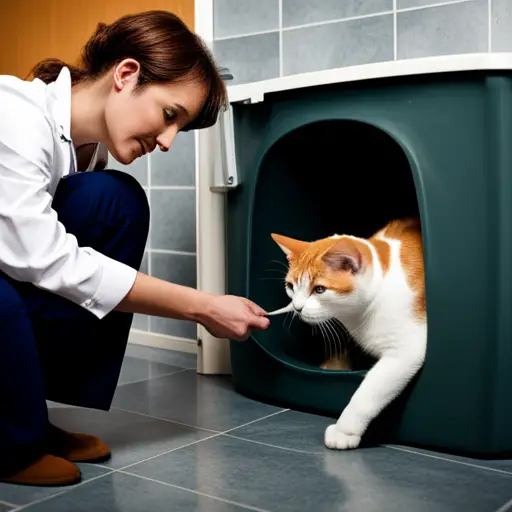Do you have a feline friend who uses a litter box? Understanding their litter box behavior is essential for their health and comfort. In this article, you’ll learn about choosing the right litter, identifying potential health problems, creating a comfortable environment, addressing undesirable behavior, and tips for maintaining a clean and healthy litter box.
Firstly, selecting the appropriate litter is crucial for you and your cat. Choosing a litter your cat will use is essential and easy for you to maintain. It can be overwhelming with so many options available, from scented to unscented, clumping to non-clumping, and natural to synthetic.
However, understanding your cat’s preferences and health needs will help you make the right choice. So, let’s dive in and explore the world of litter box behavior together!
Key Takeaways
- Observing your cat’s litter box habits can help identify potential health problems such as constipation, urinary tract infections, and diarrhea.
- Providing a comfortable environment for your cat includes placing the litter box in a quiet and private area, with multiple litter boxes available.
- Cleaning the litter box frequently is crucial to keep your cat’s litter box habits healthy and prevent health issues.
- Behavior modification can effectively address undesirable behavior in your cat’s litter box, such as increasing litter box accessibility and providing a separate scratching post.
Choosing the Right Litter

When choosing the right litter for your feline friend, you’ll want to consider their and your own cleaning preferences too.
One important factor to consider is odor control. Some litters are better than others at absorbing and neutralizing odors, which can make a big difference in the overall smell of your home. Look for litters that contain activated charcoal or baking soda, known for their odor-absorbing properties.
Another option is to choose a litter made with natural materials, such as wood chips or paper, which can also help control odors. If you’re looking for eco-friendly options, plenty of litter on the market is made from renewable resources or is biodegradable.
These litters are often made from materials like corn, wheat, or recycled paper and can be a great choice for pet owners concerned about their environmental impact. However, remember that some eco-friendly litters may not be as effective at controlling odors as traditional clay litters, so you may need to experiment with different options to find the right fit for your cat and home.
Ultimately, choosing the right litter is an important part of keeping your cat happy and healthy, so take the time to consider your options and find a litter that works for both you and your feline friend.
Identifying Potential Health Problems

You can identify potential health problems in your furry friend by observing their litter box habits. As a responsible cat owner, noticing any unusual behavior regarding their bathroom routine is important.
Here are some common issues you should look out for and some preventative measures you can take to keep your cat healthy:
- Constipation: If your cat struggles to pass stool or hasn’t defecated in over 48 hours, it’s a sign of constipation. To prevent this, ensure your cat gets enough fiber and stays hydrated.
- Urinary tract infection: Signs of discomfort during urination, frequent trips to the litter box, and blood in the urine are all signs of a UTI. Ensure your cat drinks enough water and consider a urinary tract formula food to prevent this issue.
- Diarrhea: Loose stool or diarrhea can be caused by several things, including stress, dietary changes, or an infection. Keeping your cat’s diet consistent and ensuring they are not eating anything shouldn’t help prevent this issue.
If you notice any of these signs of discomfort, it’s important to seek veterinary care immediately. Ignoring these issues can lead to further complications and potentially life-threatening situations.
By understanding your cat’s litter box behavior, you can take preventative measures to ensure they stay healthy and happy.
Creating a Comfortable Environment

When creating a comfortable environment for your cat, remember a few key things. First, ensure the litter box is placed in a quiet and private area, away from high-traffic areas and loud noises.
It’s also important to provide multiple litter boxes, especially if you have more than one cat, to avoid territorial issues.
And lastly, make sure to regularly clean and maintain the litter boxes to keep them fresh and inviting for your feline friend.
Litter Box Placement
The optimal placement of the litter box is crucial for your cat’s comfort and well-being. Here are three things to consider when finding the perfect spot for your cat’s litter box:
- Privacy: Cats are sensitive creatures who prefer doing business privately. You can place the litter box in a quiet, out-of-the-way spot where your cat can do their business without feeling watched or disturbed.
- Accessibility: Make sure the litter box is easily accessible for your cat. Avoid placing it in high-traffic areas or near any loud appliances that could scare your cat away. If your cat’s mobility is limited, place the litter box on the main floor of your home so they don’t have to navigate stairs.
- Distance from Food and Water: Cats are clean animals and don’t like their litter box too close to their food and water. Keep the litter box at least a few feet away from their feeding area to avoid contamination.
By taking the time to consider these factors, you can ensure that your cat’s litter box is in the perfect spot for them to feel comfortable and secure while doing their business. Your furry friend will thank you for it!
Providing Multiple Litter Boxes
Multiple litter boxes throughout your home can make it easier for your feline friend to find a convenient spot when nature calls. A good rule of thumb is to have at least one litter box per cat, plus an extra one. If you have two cats, you should have three litter boxes.
Litter box types also play a role in the decision-making process. Some cats prefer covered litter boxes, while others prefer open ones. Experiment with different types to see what your cat prefers.
Keeping the litter boxes in a quiet, private area is important to ensure your cat feels comfortable using them. By providing multiple litter boxes, you can make sure your cat always has a place to go when they need it.
Regular Cleaning and Maintenance
Keeping multiple litter boxes clean and well-maintained is important now that you’ve provided multiple litter boxes. Regular cleaning and maintenance are key to ensuring your cat’s litter box behavior stays consistent and healthy.
This section explores the importance of cleaning frequency and odor control.
Firstly, cleaning frequency is crucial to keep your cat’s litter box habits healthy. Dirty litter boxes can lead to infections, urinary tract problems, and other health issues that can be uncomfortable and costly for you and your feline friend.
To maintain a clean litter box, it’s recommended to scoop waste daily and replace litter weekly. This will help prevent the buildup of bacteria and unpleasant odors.
In addition to cleaning frequency, odor control is also important. While cats are generally clean animals, they produce waste that can create unpleasant smells. Consider using odor-absorbing litter or adding baking soda to the litter box to combat this.
You can also use air purifiers or deodorizing sprays to keep the surrounding area fresh. Maintaining a clean and odor-free litter box provides a comfortable and healthy environment for your furry friend to do their business.
Addressing Undesirable Behavior

Dealing with unwanted behaviors in your cat’s litter box is a common issue for many cat owners. Coming home to a mess you must clean up can be frustrating, especially if it’s a recurring problem. However, before you get too upset with your feline friend, it’s essential to understand why they’re exhibiting these behaviors in the first place. Once you understand the root cause of the issue, you can take steps to address it and help your cat learn better litter box habits.
One effective way to address undesirable behavior in your cat’s litter box is through behavior modification. This approach focuses on changing your cat’s behavior by rewarding desired actions and ignoring or redirecting unwanted actions. To help you get started, here is a table that outlines some common unwanted litter box behaviors and strategies for addressing them using behavior modification techniques:
| Undesirable Behavior | Behavior Modification Strategy |
|---|---|
| Not using the litter box | Increase litter box accessibility and make it more attractive to your cat. Reward your cat when they use the litter box. |
| Urinating or defecating outside the litter box | Clean up accidents promptly and thoroughly. Use an enzymatic cleaner to remove any lingering odors that may attract your cat back to the same spot. Provide a separate litter box for each cat in your household. |
| Digging or scratching excessively in the litter box | Use a larger litter box and increase the amount of litter you use. Provide a separate scratching post to satisfy your cat’s natural urge to scratch. Reward your cat when they use the scratching post instead of the litter box. |
With patience and consistency, you can help your cat learn better litter box habits and avoid unwanted behaviors in the future. Remember to be kind and understanding, as your cat is just trying to communicate their needs and desires in the best way they know-how. Working together can create a more harmonious household for you and your furry friend.
Tips for Maintaining a Clean and Healthy Litter Box

To keep your furry friend healthy and happy, it’s crucial to maintain a clean litter box that they’ll want to use. One of the most important things you can do is prevent odor from building up. This means scooping out waste regularly and completely changing the litter at least once a week. You can also use odor-neutralizing litter or add baking soda to the litter to help absorb smells.
Reducing tracking is another important aspect of maintaining a clean litter box. Cats are notorious for tracking litter all over the house, but there are a few things you can do to minimize this. One option is to use a litter mat outside the box to catch any litter that falls off your cat’s paws.
Another option is to choose a litter that is less likely to stick to your cat’s fur, such as larger pellets or crystals. By taking these steps, you can ensure that your cat has a clean and healthy place to do its business while keeping your home smelling fresh and tidy.
Conclusion
Now that you’re better understood your cat’s litter box behavior, you can take steps to ensure they’re happy and healthy.
Choosing the right litter and identifying potential health problems are key components to maintaining a clean and comfortable environment for your feline friend.
But don’t forget about addressing undesirable behavior and consistently maintaining a clean and healthy litter box.
With these tips and tricks, you can have a happy and healthy cat who always uses its litter box.
Remember, a little effort goes a long way in keeping your cat content and your home smelling fresh.

